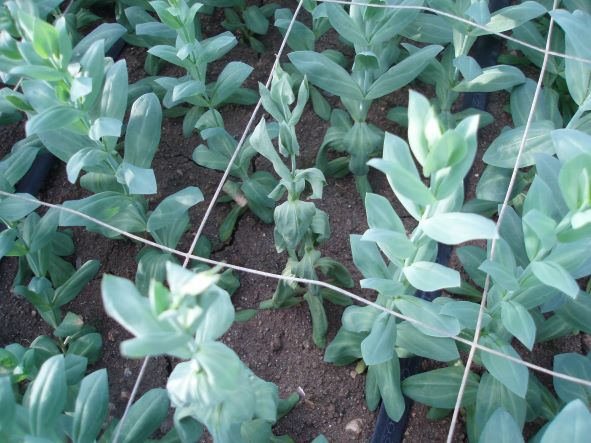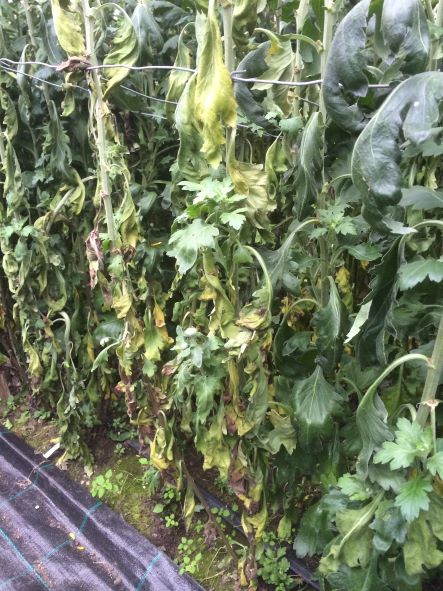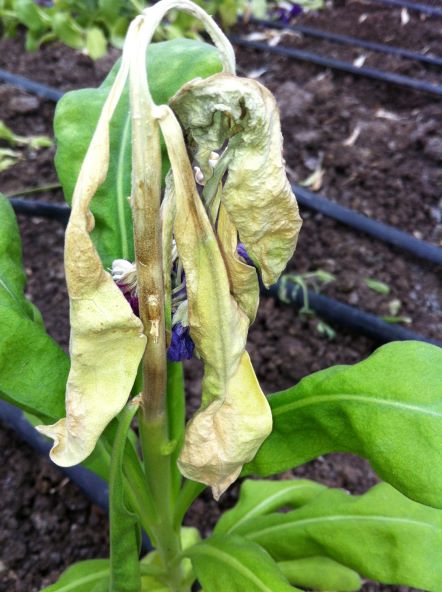Please click here to access the main AHDB website and other sectors.
- Home
- Knowledge library
- Soil disinfestation options for cut flower growers
Soil disinfestation options for cut flower growers
The withdrawal of all chemical fumigant options for cut flower growers means alternative ways to reduce the occurrence of soilborne pathogens, pests and weeds need to be adopted. These pages highlight practical information on steam treatment options and experimental results of alternatives to help growers make the best choice for their own production system. Follow the links below to learn more.
Why disinfect soils?
Soil disinfestation in cut flower production is used primarily to limit damaging outbreaks of soilborne diseases. Historically, it has been a key management tool for many growers of protected Chrysanthemum, column stocks and Lisianthus to control pathogens such as Fusarium wilt, Pythium root rot and Verticillium wilt. It is also used against other serious root rot pathogens, including Phytophthora, Rhizoctonia and Sclerotinia sclerotiorum.
It is used against nematodes, such as root-lesion nematode on Alstroemeria, and soilborne insect pests. However, damaging attacks by these pests are relatively rare.
Soil disinfestation is also important for weed control, especially now that the availability of effective and crop-safe herbicides is more limited.
For field-grown crops, effective disinfestation enables continued production on the best sites, such as high-quality fertile soils and land close to packhouses. It is also of great benefit following investment in glasshouses on new sites, by helping to maintain a high percentage output.
When should you disinfect soils?
Soilborne pathogens, and to a lesser extent soilborne nematodes, pests and weeds, increase when a particular crop/species is grown on the same land year on year. The risk is greatest during all-year-round production of crops such as protected Chrysanthemum, or multiple-cropping of column stocks and Lisianthus. The main soilborne pathogens of commonly grown cut flowers are summarised in Table 1.
Table 1. Common soil-borne diseases of some cut flowers in the UK
| Cut flower crop | Fusarium wilt | Pythium root rot | Phytophthora root rot | Rhizoctonia root rot | Sclerotinia stem rot | Verticillium wilt |
| Alstroemeria | × | |||||
| China aster | × | × | ||||
| Carnation/pinks | × | × | × | × | ||
| Chrysanthemum | × | × | × | × | × | |
| Gladiolus | × | |||||
| Helichrysum | × | |||||
| Lisianthus | × | × | ||||
| Stocks (column) | × | × | × | |||
| Sunflower | × | |||||
| Tulip (forced) | × | × | × | × | × |
Damaging soilborne pathogens: (a) Fusarium in Lisianthus

(b) Verticillium in Chrysanthemum

(c) Sclerotinia in column stocks

Image (a) courtesy and copyright of ADAS Horticulture, images (b) and (c) courtesy and copyright of Lyndon Mason.
What method should you use?
Having decided that soil disinfestation is necessary, the most appropriate method(s) of treatment will depend on:
- The efficacy of the procedure against the target soilborne pathogens, pests and weeds
- The ease and method of utilisation at your site and how it fits in with your growing system
- The interval between treatment and when it is considered safe to re-plant
- The cost of treatment
Historically soil disinfestation via chemical fumigation was the most popular method, including the use of chloropicrin, dazomet, 1-3-dichloropropene, formaldehyde, methyl bromide and metam-sodium. As of 2020, however, all chemical fumigant products have been withdrawn, leaving only non-chemical options.
Action points
- Assess the risk of a serious soilborne pathogen, pest or weed problem based on the inherent susceptibility of the crop being planted and crop records
- Keep records of soilborne pathogen, pest and weed problems in previous crops, and use this information to aid decisions on the need to disinfest soil
- Be aware of whether pathogens or pests are either harboured in plant debris on or near the soil surface or are associated with deep roots
- Where soil disinfestation is considered necessary, identify the methods and equipment that need to be purchased or hired and the availability of trained labour
- Prepare the soil as recommended to maximise treatment efficacy, including soil tilth, moisture content, temperature, debris removal, etc.
- Ensure the treatment is applied according to good practice and is done safely, such as ensuring effective sealing of the soil surface
- Use soil temperature probes when soil steaming to check that the target temperature is achieved at the required depth
- Analyse soil nutrient levels and adjust feeding accordingly after steam treatment
- Ensure that footwear and machinery are cleaned before entering locations with newly disinfested soil
- Make sure you do not cultivate too deeply after disinfestation as this can bring up contaminated soil
Use other appropriate methods of pathogen, pest and weed control to supplement the level of control achieved by soil disinfestation, including good nursery hygiene, crop rotation and use of plant protection products. The impact of some pathogens or pests may be reduced by variety selection.
Steaming options for soil disinfestation
Many methods of soil disinfestation using steam have been employed over the years. When done correctly, the procedure has a broad spectrum of activity and efficacy, though treatment to depth can be difficult to achieve.
Find out more about the steaming options for soil disinfestation
Alternative soil disinfestation options
Several non-steam soil disinfestation options are available or in development, although their current applicability to intensive cut flower production is limited.
Find out more about the alternative disinfestation options
Integrated management of soilborne pathogens
There is no simple, single measure that will provide reliable control of soilborne pathogens. However, by thorough soil disinfestation, use of suitable plant protection products at planting, frequent crop monitoring, prompt removal of affected plants (if only a few are affected), minimising crop debris incorporated into the soil, and general good hygiene, it should be possible to keep soilborne pathogens a low level.
Developing an integrated approach
Useful links
Read the AHDB crop walker guide for cut flowers to familiarise yourself with the range of soilborne issues mentioned in these pages. More specific information on Fusarium wilt in column stocks can be found in the AHDB/CFC Information sheet 4 ‘Summary of the Cut Flower Centre trial examining the susceptibility of a wide range of different varieties of column stocks to fusarium wilt’ and the AHDB/HDC factsheet 08/07 'Integrated management of stock fusarium wilt’.
AHDB Cut Flowers Crop Walkers’ Guide
HDC/AHDB factsheet 08/07 ’Integrated management of stock fusarium wilt’
Authors
Author(s) – Dave Kaye and Erika Wedgwood. ADAS Horticulture.
Original author(s) – Tim O’Neill and Kim Parker. ADAS Horticulture.
Webpage content correct as of June 2021.
Soil disinfestation is used to reduce serious soilborne problems such as Fusarium wilt in cut flower column stocks

Courtesy and copyright of Lyndon Mason.
Topics:
Sectors:
Tags:

